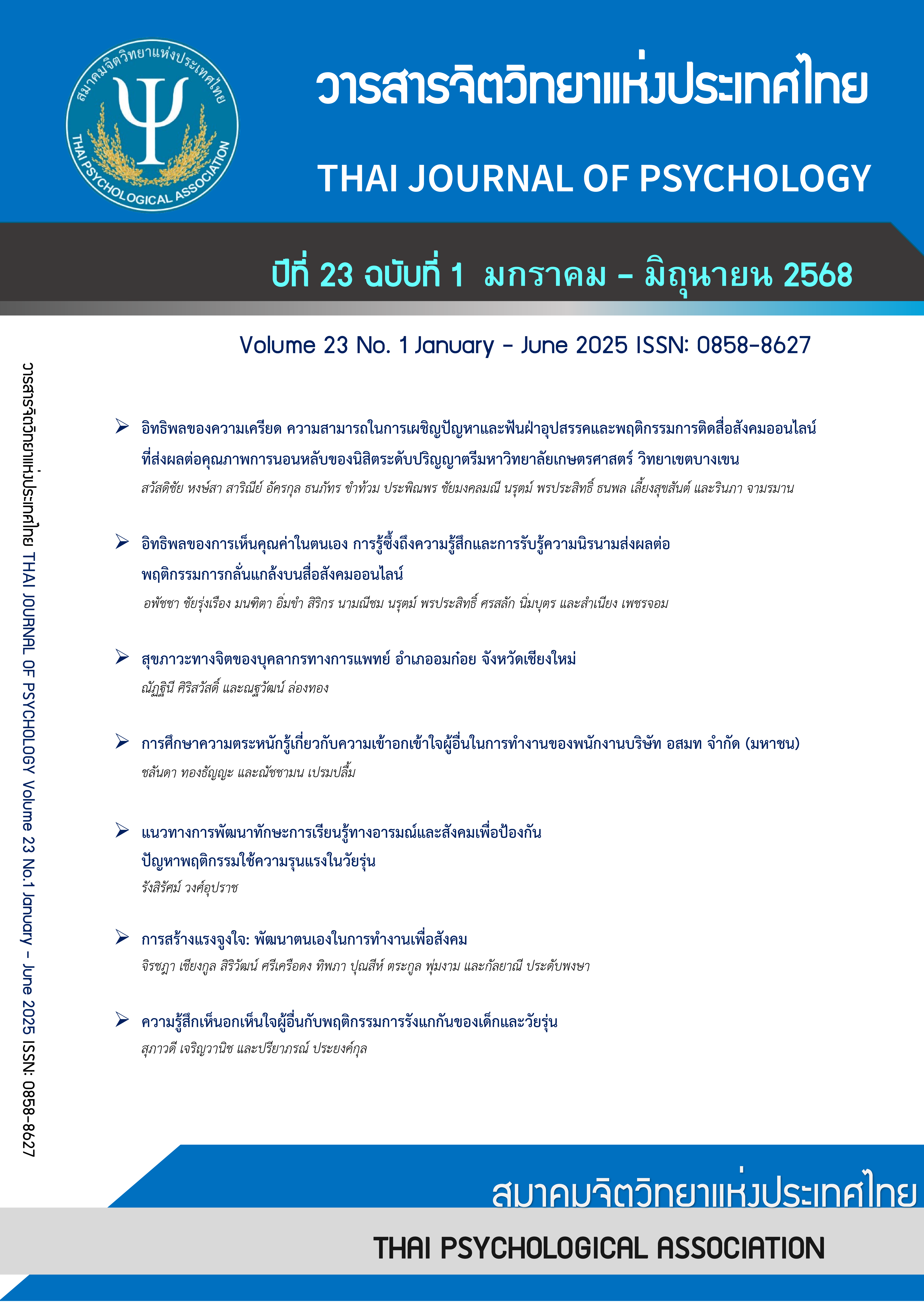A A STUDY OF EMPATHY IN THE WORKPLACE OF MCOT PUBLIC COMPANY LIMITED EMPLOYEES
Keywords:
Empathy, Developing empathy, Employee work, EmployeeAbstract
The objective of this research is to study awareness about “Empathy” in
the workplace of executives and employees of MCOT Public Company Limited, including suggestions for developing “Empathy” in the workplace of executives of MCOT Public Company Limited by studying from a sample group. There were 6 senior executives and operational employees, 10 people from 5 offices, totaling 16 people. The research tools included in-depth interviews with open-ended questions about empathy in the workplace were conducted to enable the sample to analyze and compile responses that were complete and consistent with the study objectives. From this research, it was found that the sample group had awareness of empathy towards coworkers within the organization because there are 5 components of empathy according to the Goleman’s (1998) concept: Understanding others, Developing others, Service orientation, Leveraging diversity, and Political awareness. And in terms of suggestions for developing empathy, the executives of MCOT Public Company Limited proposed two approaches: setting goals for building the teamwork and doing activities to develop empathy, which is an important social skill that helps to understand and feel others' emotions, which helps develop relationships between co-workers and enhances good efficiency within the organization.
References
เอกสารอ้างอิง
มูลนิธิยุวพัฒน์. (20 พฤศจิกายน 2566). Empathy การเห็นอกเห็นใจผู้อื่น. สืบค้นจาก https://www.yuvabadhanafoundation.org/th/ข่าวสาร/บทความทั่วไป/empathy-mental-health/
นภดล ร่มโพธิ์. (2 กรกฎาคม 2562). ทุกเรื่องที่อาจยังไม่เคยรู้ของ OKR จาก ศ.ดร.นภดล ร่มโพธิ์.
The Standard. สืบค้นจาก https://thestandard.co/podcast/thesecretsauce126/
สมาคมนักข่าวนักหนังสือพิมพ์แห่งประเทศไทย. (2567). รายงานสถานการณ์สื่อมวลชนในรอบปี 2567
: ปีแห่งความยากลำบากของสื่อมวลชน. สืบค้นจาก https://tja.or.th/view/activities/media-situation/1453282
สหธร เพชรวิโรจน์ชัย. (2564). รู้จัก Empathy Skill ทักษะที่ทำให้เข้าใจความรู้สึกคนอื่นมากขึ้น. สืบค้นจาก https://th.hrnote.asia/orgdevelopment/empathy-skill-210714/
สุภางค์ จันทวานิช. (2559). วิธีการวิจัยเชิงคุณภาพ (พิมพ์ครั้งที่ 23). จุฬาลงกรณ์มหาวิทยาลัย.
A Britain Healthiest. (2015). Health, wellbeing and productivity in the workplace: A Britain's Healthiest Company summary report. RAND Corporation, UK. https://www.rand.org/pubs/research_reports/RR1084.html
Baron-Cohen, S., & Wheelwright, S. (2004). The Empathy Quotient: An investigation of adults with Asperger Syndrome or High Functioning Autism, and normal sex differences. Journal of Autism and Developmental Disorders, 34(2), 163-175. https://doi.org/10.1023/b:jadd.0000022607.19833.00
Batson, C. D. (1991). The altruism question: Toward a social psychology of compassion and caring. Psychology Press.
Boddy, C. R. (2016). Sample size for qualitative research. Qualitative Market Research: An International Journal, 19(4), 426-432.
Businessolver. (2017). 2017 Workplace empathy monitor Report. https://info.businessolver.com/hubfs/businessolver-workplace-empathy-monitor-2017.pdf
Chartered Institute of Personnel and Development. (2023). Health And Wellbeing At Work Survey Report. https://www.cipd.org/globalassets/media/knowledge/knowledge-hub/reports/2023-pdfs/8436-health-and-wellbeing-report-2023.pdf
CPP Global. (2008). Workplace Conflict And How Businesses Can Harness It To Thrive. https://shop.themyersbriggs.com/Pdfs/CPP_Global_Human_Capital_Report_Workplace_Conflict.pdf
Fox, J., & Moreland, J. J. (2015). The dark side of social networking sites: An exploration of the relational and psychological stressors associated with Facebook use and affordances. Computers in Human Behavior, 45, 168-176. https://doi.org/10.1016/j.chb.2014.11.083
Goleman, D. (1998). Working with Emotional Intelligence. Bantam Books.
Goleman D. (2001). An EI-based theory of performance. In C. Cherniss & D. Goleman (Eds.), The Emotionally Intelligence Workplace, (1st ed. pp. 27-44). Jossey-Bass.
Google Trends. (2024). Search term: Empathy. https://trends.google.com
Hoffman, G. D. (2009). Applying principles of leadership communication to improve mediation outcomes. Dispute Resolution Journal, 64(3), 24-29. http://www.digitalsmarttools.com/eHoffmann/Hofffmann-Docs/Applying_Principals_of_Leadership_Communication_to_Improve_Mediation_Outcomes.pdf
Holt, S. (2022). Nurturing empathy. In J. Marques (Ed.), Innovative Leadership in Times of Compelling Changes (pp. 117-131). Springer.
Keen, S. (2007). Empathy and the Novel. Oxford University Press.
Krauss, R. M., & Fussell, S. R. (1991). Perspective-taking in communication: Representations of others' knowledge in reference. Columbia University. https://www.columbia.edu/~rmk7/HC/HC_Readings/Krauss_Fussell.pdf
Krueger, R. A. (1998). Moderating Focus Groups, (pp. 137-142). Sage Publications. https://doi.org/10.4135/9781483328133
Lyubykh, Z. & Gulseren, D.B. (2023, 31 May). How to Take Better Breaks at Work, According to Research. Harvard Business Publishing, Health and wellness Digital Article. https://hbr.org/2023/05/how-to-take-better-breaks-at-work-according-to-research
Mayer, K. (2020). HRE’s number of the day: Coronavirus stress. Human Resource Executive. https://hrexecutive.com/hres-number-of-the-day-coronavirus-stress/
Moore, K. J., Xiong, S., Bhattacharya, M., Bustamante, G., & Calvert, C. (2020). Beyond diversity: focusing on and enhancing inclusion in the Society for Epidemiologic Research. American Journal of Epidemiology, 189(10), 1042-1046.
Rahman, W. (2016). Empathy and trust: Into a better workplace environment. Journal of Business and Economics, 7(12), 2090-2099.
Ritchie, J. & Spencer, L. (2002). Qualitative Data Analysis for Applied Policy Research. In A. M. Huberman, & M. B. Miles (Eds.), The Qualitative Researcher’s Companion. SAGE Publications.
Rogers, C. R., & Richard, E. F. (1987). Active listening. In R.G. Newman, M.A. Danzinger, & M. Cohen (Eds.), Communicating in Business Today. D.C. Heath & Company.
Sadri, G. (2012). Emotional intelligence and leadership development. Public Personnel Management, 41(3). https://doi.org/10.1177/009102601204100308
Published
How to Cite
Issue
Section
License
Copyright (c) 2025 Thai Psychological Association

This work is licensed under a Creative Commons Attribution-NonCommercial-NoDerivatives 4.0 International License.
บทความที่ได้รับการตีพิมพ์เป็นลิขสิทธิ์ของสมาคมจิตวิทยาแห่งประเทศไทย
ข้อความที่ปรากฎในบทความแต่ละเรื่องในวารสารวิชาการเล่มนี้เป็นความคิดเห็นส่วนตัวของผู้เขียนแต่ละท่านไม่เกี่ยวข้องกับสมาคมจิตวิทยาแห่งประเทศไทย แต่อย่างใด ความรับผิดชอบองค์ประกอบทั้งหมดของบทความแต่ละเรื่องเป็นของผู้เขียนแต่ละท่าน หากมีความผิดพลาดใด ๆ ผู้เขียนแต่ละท่านจะรับผิดชอบบทความของตนเองแต่ผู้เดียว






